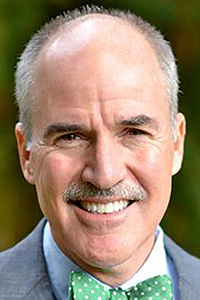
Peter Kilmarx MD’90, deputy director of the Fogarty International Center at the National Institutes of Health, laid out important insight and advice for those seeking globally focused careers as part of a special presentation Oct. 8.
During “Perspectives on Global Health Research and Careers,” Kilmarx gave both detailed and high-level insight into global health activities, the current research landscape, and effective ways to build a career. He told attendees to take their journey one step at a time, and to always make an impact as a collaborator while keeping an eye to the future.
“Don’t think about what I am going to do in 20 years,” he said. “Think about what I am going to do in five.”
During the talk, co-presented by The Warren Alpert Medical School and the School of Public Health, Kilmarx drew on his own experiences as an expert on infectious disease research and HIV/AIDS prevention. He recounted his time working in regions of Africa, his senior positions at the CDC, and the overall benefits and opportunities for pursuing careers in global health research. Exposure to unique populations, environmental experiences, and interventions can broaden approaches and insights into potential treatment and patient populations, and researchers can also gain insight into alternative health systems in other nations.
Kilmarx gave the example of a study carried out by a grantee in Columbia focused on a large family cohort that had an autosomal dominant form of Alzheimer’s disease, meaning every family member with this specific gene would develop the disease by the time they reached their 40s. The opportunity to study the largest known family with an inherited, early-onset form of Alzheimer’s offered unique insights that would have otherwise been difficult to research with solely domestic patient populations. The discovery of another gene in the family that actually lowers the risk of the disease make it a robust example of global collaboration.
“If you wanted to do a study of a biomarker, or of a preventive intervention, on an undifferentiated population in the US, you would need thousands of people and a decade to see if it works or not,” he explained.
Kilmarx also used one of his own studies to make a case for the importance of global health. He worked alongside Joshua Grubbs, MD, and found 35 percent of NIH-funded publications from 2009 to 2017 had a non-US affiliated co-author and those that have both US and non-US co-authors had the greatest mean citation impact score. He recommended those with a burgeoning interest in global health research utilize NIH’s World Report website, which offers a glimpse into 16 major funding agencies, grant records, and maps for direct awards and collaborating research networks and can show where specific research is taking place and where there may be opportunities for partnerships.
“A key message here is that every NIH institute and center that funds extramural research funds global international collaborations,” he said. “If you’re thinking about how to get NIH funding to work globally, you can think outside of the box. It may be oral health you’re actually working on, or it may be something related to deafness or communication disorders, or alcohol abuse. There is really broad support from NIH for these global collaborations.”
He highlighted Fogarty’s efforts in building sustainable global health research capacity both at home and abroad, and pointed to the institution’s HIV research training programs. With 110 grants in 28 countries, and thousands of short- and long-term trainees worldwide, the organization provides individual training opportunities and awards, like the International Research Scientist Development Award and the Emerging Global Leader Award. Both offer up to 5 years of mentored support, and Kilmarx emphasized the role such mentors can play in building support and networks to seize opportunities as they come along.
“If you think your passion is the left kidney, but the best mentor is in the right kidney laboratory, go work for the latter,” he said. “Finish what you’re doing and show impact, but when someone says ‘Do you want to go do this amazing thing,’ say yes.”
Watch the lecture below.